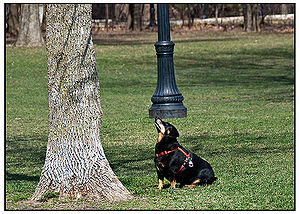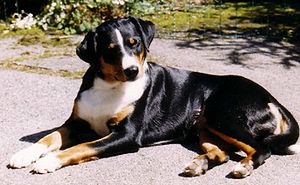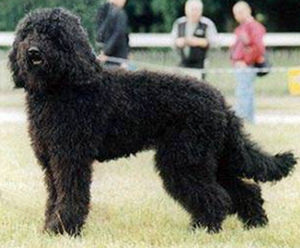 |
| Vital Statistics: |
| Place of Origin: Hungary |
| Group: Sporting, Gun Dog |
| Height: males 22-24 in., females 21-23 in. |
| Weight: males 45-60 lbs., females 40-55 lbs. |
| Life span: 11 yrs. |
| Trainability: high |
| Good with children: yes, if socialized early |
| Good with other pets: yes, if socialized as pups |
What are the origins of the Vizsla?
The Vizsla can trace its ancestry back more than 1,000 years to the hunting dogs of Magyar tribesmen living in Central Europe. It was a favorite with Hungarian noblemen who bred it with the best qualities of the pointer and the retriever. The Vizsla was saved from extinction after the two World Wars by caring people and arrived in the U.S. in 1950 where it soon became a popular breed.
What does the Vizsla look like?
The Vizsla is a medium sized, lean, muscular dog. Height is 21-24 inches tall and weight about 40-60 lbs. depending on gender. The long ears are pendant and round at the tip. The nose is brown and eye color blends with coat color. The tail is docked to 2/3 its length. The coat is short and smooth. Color is solid shades of golden rust, sometimes with a small white spot on the chest or white toes. The Vizsla’s coat needs weekly brushing and a bath every other month. Ears should be checked regularly.
What is the temperament of the Vizsla?
The Vizsla is a highly intelligent, sensitive dog that trains easily with a firm, but gentle hand. It needs early socialization with children and supervision with toddlers. It is a hunting dog and socialization with other pets needs to begin early. The Vizsla is a high energy dog and needs vigorous exercise and room to run to avoid getting into mischief. As an owner, you must be willing to spend time and energy with this dog. The Vizsla likes living indoors with the family, so keeping it outdoors in a kennel is not advisable.
What are the uses of the Vizsla?
Bred for hunting, the Vizsla still participates in the sport. Highly trainable, the Vizsla is an outstanding sporting dog. There are a very affectionate, loving addition to the family.
Possible Health Issues
Epilepsy, von Willebrand’s Disease, entropion, progressive retinal atrophy, cataracts, hip dysplasia, hypothyroidism, cancers
- American Cocker Spaniel
- Boykin Spaniel
- Bracco Italiano
- Brittany Spaniel
- Chesapeake Bay Retriever
- Clumber Spaniel
- Curly-coated Retriever
- Dalmatian
- English Setter
- English Springer Spaniel
- German Shorthaired Pointer
- Gordon Setter
- Irish Red & White Setter
- Japanese Akita Inu
- Kai Ken Dog
- Karelian Bear Dog
- Labrador Retriever
- Lagotto Romagnolo
- Llewellyn Setter
- Mountain Cur
- Nova Scotia Duck Tolling Retriever
- Picardy Spaniel
- Pudelpointer
- Russian Spaniel
- Spinone Italiano
- Weimaraner
- Welsh Springer Spaniel
- Welsh Terrier
- Wetterhoun
- Wirehaired Pointing Griffon
- Wirehaired Vizsla
- American Cocker Spaniel
- Barbet
- Boulet Griffon
- Boykin Spaniel
- Bull Terrier
- Clumber Spaniel
- Curly-coated Retriever
- Dalmatian
- English Cocker Spaniel
- English Setter
- English Springer Spaniel
- Flat-coated Retriever
- German Shorthaired Pointer
- Golden Retriever
- Gordon Setter
- Harrier
- Irish Setter
- Irish Water Spaniel
- Kishu Inu
- Kooiker Hound (Kooikerhondje)
- Labrador Retriever
- Lagotto Romagnolo
- Landseer
- Mountain Cur
- Nova Scotia Duck Tolling Retriever
- Otterhound
- Picardy Spaniel
- Poodle
- Pudelpointer
- Redbone Coonhound
- Redtick Coonhound
- Rhodesian Ridgeback
- Spinone Italiano
- Stabyhoun
- Sussex Spaniel
- Telomian
- Treeing Tennessee Brindle
- Weimaraner
- Welsh Springer Spaniel
- Wirehaired Pointing Griffon
- Wirehaired Styrian Mountain Hound
- Wirehaired Vizsla



